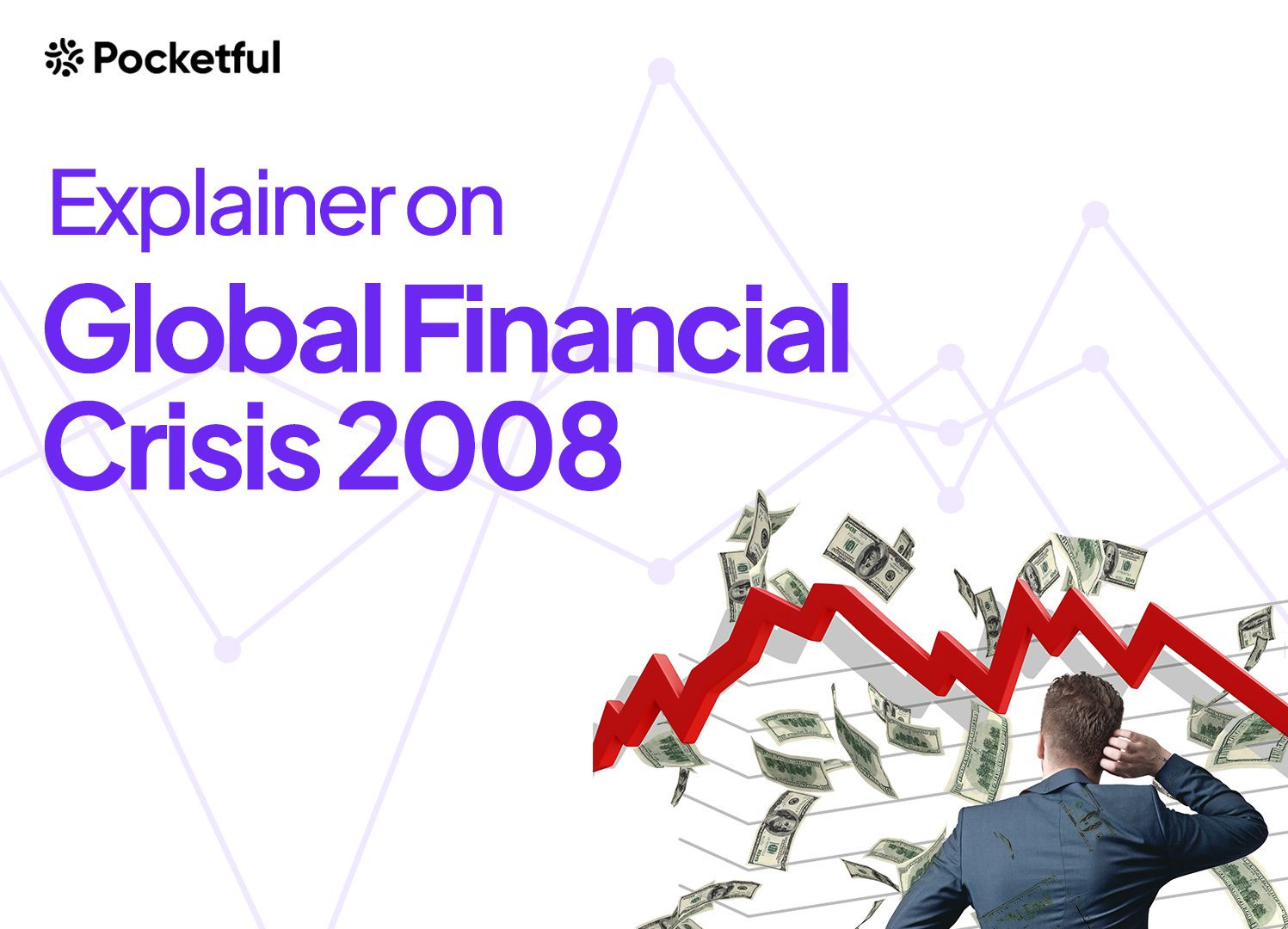| Type | Description | Contributor | Date |
|---|---|---|---|
| Post created | Pocketful Team | Mar-27-24 | |
| Add new links | Nisha | Apr-11-25 |

- Blog
- explainer on global financial crisis 2007 08 causes key events and impact on indian stock markets
Global Financial Crisis 2007-08: Causes, Key Events, and Impact on Indian Stock Markets

We distinctly remember the aftermath of the Global Financial Crisis 2007-08, but very few of us know the reasons behind its occurrence. It was not a sudden event but rather a culmination of risky practices and vulnerabilities within the financial system.
What began as a seemingly positive trend in the housing market ultimately unraveled into a domino effect that weakened the global economies.
Today’s blog discusses the causes of the Global Financial Crisis, the unfolding drama, and its lasting impact.
Global Financial Crisis 2007-08
The Global Financial Crisis, also known as the 2007-08 financial crisis, was a severe economic downturn that began in the United States and then spread throughout the world. It is regarded as the most serious economic crisis since the Great Depression.

Global Financial Causes 2007-08
The causes of global financial crisis 2007-08 were not due to a single factor but rather a combination of systemic issues within the financial system. Here are some key causes.
- Subprime Mortgage Crisis
One of the primary triggers was the collapse of the housing market bubble in the United States, fuelled by the issuance of subprime mortgages. These mortgages were given to borrowers with poor credit history or insufficient income to afford them and were often bundled together into complex financial instruments called mortgage-backed securities (MBS). The assumption was that housing prices would keep rising, making these investments safe. When many of these borrowers defaulted on loans, the value of mortgage-backed securities significantly declined.
- Lack of Regulation
Financial Institutions were allowed to take on excessive risk with little oversight. There were lax regulations on mortgage lending practices and the creation of MBS, which masked the underlying risk. The risk profile of MBS products was downplayed to make them seem more attractive to investors and also opened the door to fraudulent practices like income falsification.
- Bubble Burst
Fuelled by easy credit, housing prices soared in many countries, creating a bubble. When the bubble burst, house prices plummeted, and many homeowners defaulted on their mortgages. This triggered a wave of defaults on MBS, causing their value to collapse. Banks and investors also engage in short-term borrowings like overnight loans to buy illiquid assets, which is risky. This created a situation where they depended heavily on lenders constantly renewing these loans to avoid defaulting.

Global Financial Key Event 2007-08
With trigger points in the US housing market causing a domino effect, the Global Financial Crisis (GFC) unfolded like a disaster movie in slow motion.
- Low-interest rates and deregulation in the mortgage industry fuelled a surge in risky lending practices.
- Subprime mortgages became increasingly common. Fuelled by easy credit, housing prices soared and people bought houses they could not afford.
- When interest rates started to rise and the housing market was at its peak, many homeowners defaulted, leading to a wave of foreclosures, with millions losing their homes.
- As the value of MBS dropped, financial institutions that held them faced massive losses. Banks became wary of lending to each other, fearing insolvency, which froze credit markets.
- The panic spread throughout the financial system. Major investment banks like Lehman Brothers collapsed, and stock markets around the world crashed.
- Businesses struggled to get loans, hindering their ability to invest and grow. This led to widespread layoffs and a global recession.
- To prevent a complete economic meltdown, governments around the world implemented bailout packages for banks and stimulus programs to revive the economy.
The GFC’s impact was far-reaching, causing widespread unemployment, economic hardship, and a major loss of trust in the financial system. The recovery process was slow and uneven, highlighting the need for stricter regulations and a more responsible approach to lending practices.
Read Also: Trading For Beginners: 5 Things Every Trader Should Know
Impact on Indian Stock Markets
The GFC of 2008 had a significant impact on the Indian markets, even though India was not directly at the centre of the storm.
- As risk gripped global investors, FIIs pulled out funds from the Indian Stock Market. This exodus of foreign capital led to a sharp fall in stock prices.
- With global risk rising, the Indian Rupee depreciated significantly against the US dollar. It fell roughly 20% between April 2008 and November 2008, eventually making imports costlier. However, the RBI took measures to stabilize the situation.
- The BSE SENSEX witnessed a sharp fall, dropping over 56% between its peak in January 2008 and its trough in November 2008.

Corrective Actions Taken by the RBI
The RBI could not single-handedly control the GFC since it was a global phenomenon. However, some important steps were taken to mitigate the crisis.
- The RBI injected liquidity into the financial system through open market operations which helped ease credit flow for businesses and individuals.
- The Repo rate was lowered (the rate at which RBI lends money to commercial banks). This made it cheaper for banks to borrow reserves and lend further.
- The RBI sold US Dollars from its foreign exchange reserves to support the rupee’s value during its depreciation phase.
While the measures could not completely prevent the slowdown, RBI helped India bear the storm of the GFC.
Read Also: How does the Price of Oil affect the Stock Market?
Conclusion
The GFC’s scars ran deep. It was not just a financial crisis but a turning point in our lives. It eroded public trust in financial institutions, widened the gap between rich and poor, and fuelled social unrest.
The long-term implications of the GFC can still be felt while shaping economic policies and understanding risk. Though the global economy eventually recovered, the GFC is a stark reminder of the importance of responsible lending practices and a commitment to financial stability.
Frequently Asked Questions (FAQ)
What was the Global Financial Crisis?
The GFC was a major financial crisis that began in 2007 and had severe repercussions globally. It originated from the US housing market collapse.
In which year did GFC happen?
GFC happened in the year 2007.
How did the GFC impact the global markets?
Stock markets worldwide crashed, with some indices dropping over 50%. Volatility surged and highlighted investors’ fear, and interbank lending came to a standstill due to fear of insolvency.
What was the long-term impact of the GFC?
The GFC led to stricter regulations. The focus on risk management increased and investors became more cautious in emerging markets.
How did GFC unfold?
GFC unfolded in multiple stages. It started from the Housing bubble and subprime lending in the middle 2000s, bubble bursts (2006-07), MBS unraveling and financial panic (2008) and global recession (2008-09).
Disclaimer
The securities, funds, and strategies discussed in this blog are provided for informational purposes only. They do not represent endorsements or recommendations. Investors should conduct their own research and seek professional advice before making any investment decisions.